Introduction
Autism Speaks, a prominent organization in the autism advocacy landscape, has been a focal point of both support and significant criticism since its inception in 2005. The organization's journey is marred by controversies, such as the infamous 2009 "I Am Autism" video and its historical emphasis on curing rather than understanding autism. Critics argue that Autism Speaks has often sidelined the voices of autistic individuals, focusing more on fundraising and awareness than on meaningful inclusion and support.
This article delves into the various criticisms leveled against Autism Speaks, including its lack of autistic representation, problematic media portrayals, financial allocation issues, and contentious endorsement of therapies like Applied Behavior Analysis (ABA). It also explores ethical concerns regarding prenatal testing and the silencing of autistic voices, while highlighting the rise of alternative organizations that prioritize neurodiversity and inclusivity. Understanding these dynamics is crucial for fostering a more supportive and accepting environment for the autism community.
Historical Controversies and Criticisms
Autism Speaks, founded in 2005, has faced significant scrutiny over the years. Critics argue that the organization has often placed more emphasis on fundraising and awareness campaigns, rather than prioritizing the voices of autistic individuals and their families. One of the most notable controversies involves the 2009 “I Am Autism” video, which was widely criticized for its negative portrayal of the condition. Although the video was removed shortly after its release and Autism Speaks has since apologized, stating it does not reflect the organization's current stance, the damage to their reputation was already done.
Another major point of contention is the organization's historical framing of the condition predominantly as a disorder in need of curing, rather than embracing it as a neurodiverse phenomenon deserving of understanding and acceptance. This perspective has alienated many within the neurodiverse community who advocate for a shift toward celebrating neurodiversity and providing meaningful support.
The controversy surrounding Autism Speaks underscores the importance of understanding and promoting diverse perspectives in autism advocacy. Inclusive methods that honor and elevate the perspectives of people on the spectrum are essential for creating a nurturing and welcoming atmosphere.
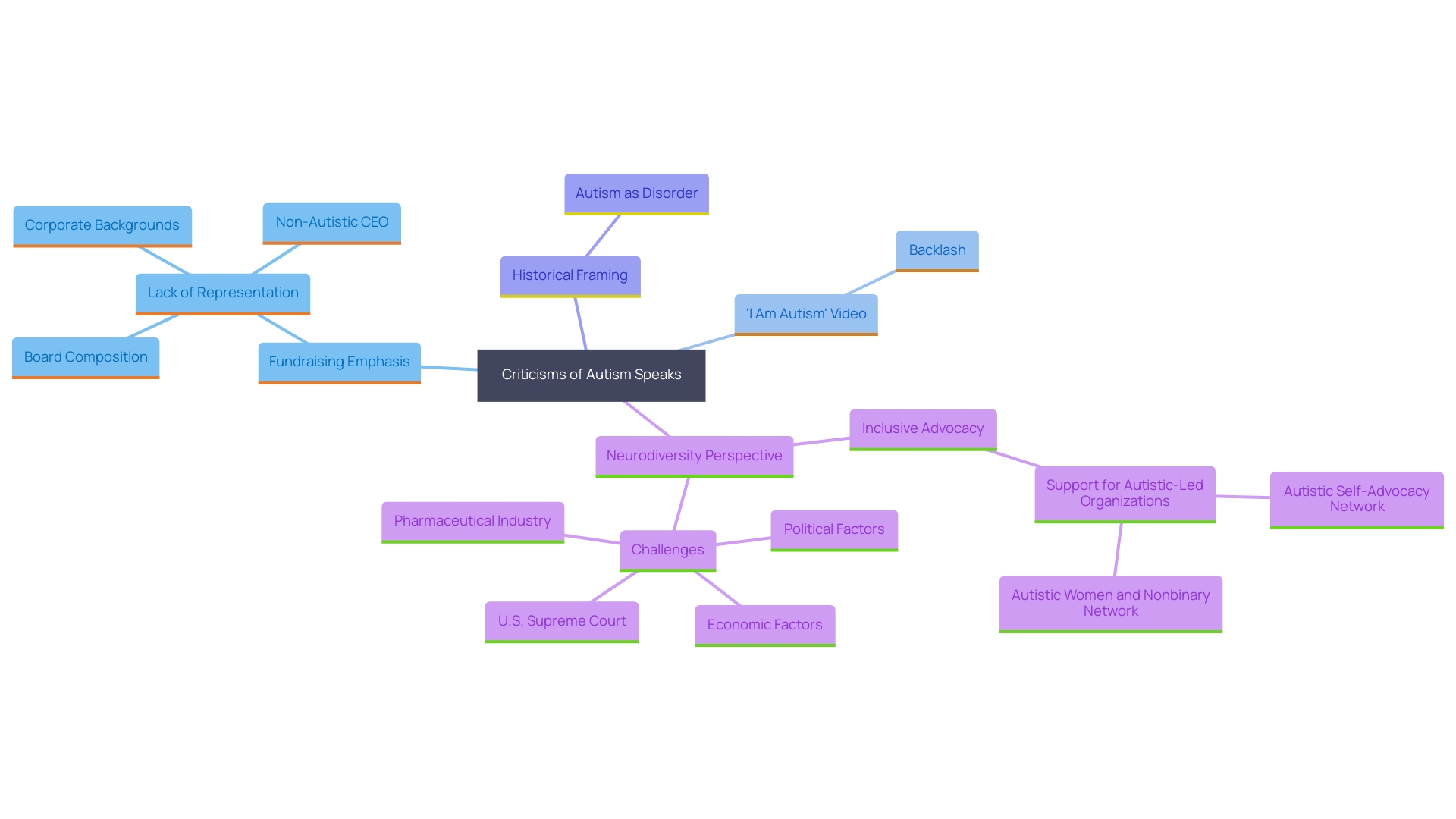
Lack of Autistic Representation
One of the most significant criticisms of Autism Speaks is the absence of individuals on the spectrum in leadership roles and decision-making processes. Many support a more inclusive approach, where individuals on the spectrum are not only heard but actively influence policies and initiatives. This lack of representation has led to feelings of alienation among the very group the organization seeks to support. The Autistic Self Advocacy Network (ASAN), for instance, is a nonprofit organization operated by and for individuals on the spectrum, ensuring that their viewpoints are central to its mission. ASAN strives to involve people on the spectrum in policymaking to address the needs of the group efficiently. The importance of incorporating lived experiences into leadership cannot be overstated, as it ensures that initiatives are both relevant and respectful to those they aim to support. Studies show that inclusive employment for neurodiverse persons not only helps the community but also stimulates economic growth, with businesses that hire workers with disabilities excelling compared to those that do not. To foster a genuine sense of inclusion, organizations must prioritize the representation of individuals on the autism spectrum in their leadership and decision-making processes.
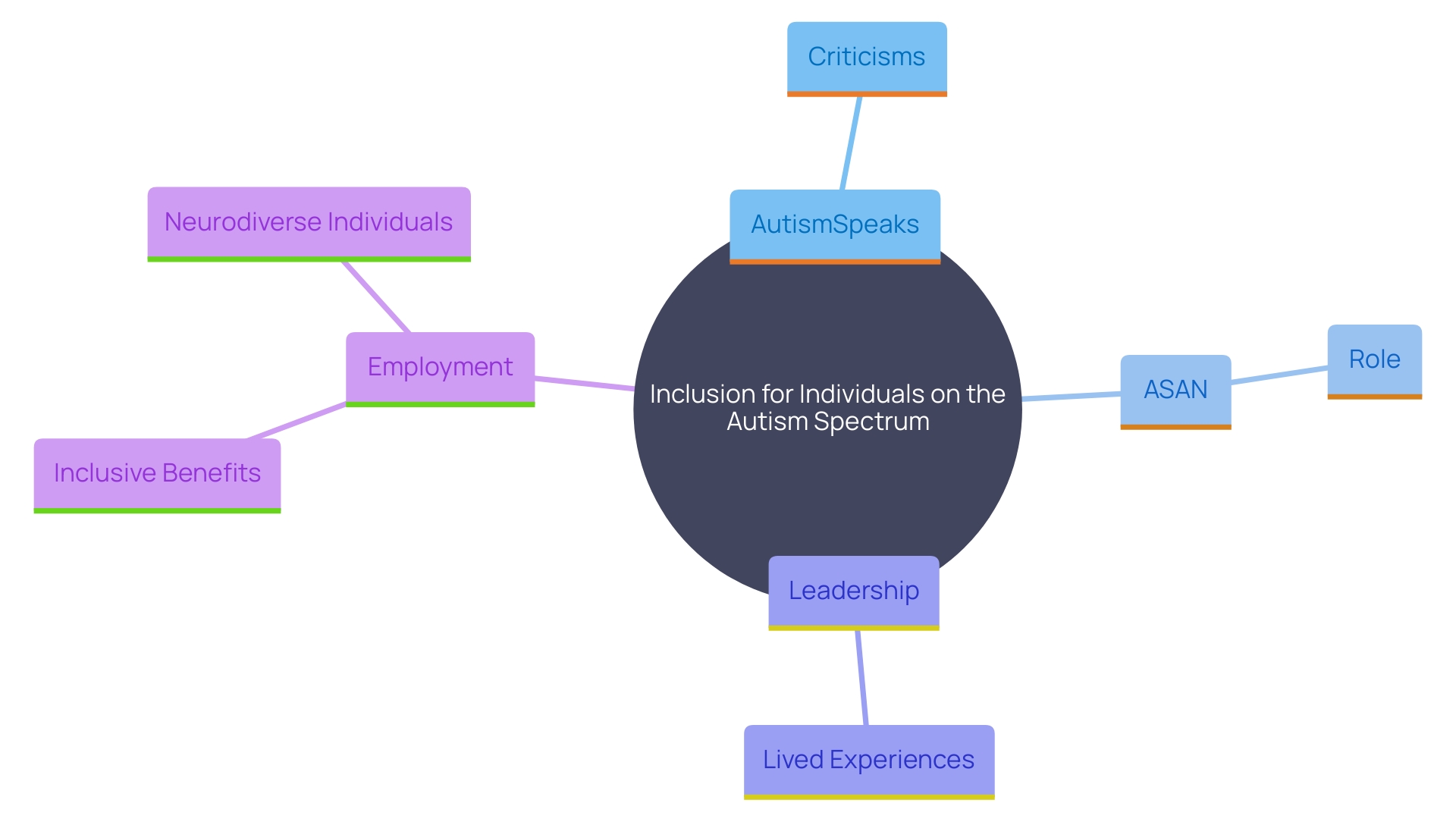
Problematic Media Portrayals
Autism Speaks has faced criticism for perpetuating negative stereotypes through its media campaigns. 'Frequently, the organization depicts the condition as a tragedy or burden, overshadowing the diverse experiences of those on the spectrum. This narrative not only fosters stigma but also deepens societal misunderstandings about autism.
Research highlights the consequences of such portrayals. 'In 'Kids Across the Spectrums,' Meryl Alper notes that people on the spectrum are frequently depicted as symbols reflecting non-disabled people's values, rather than as persons with rights and agency.'. 'This dehumanization is worsened by a lack of real-life studies and the tendency to compare people on the spectrum to machines, perpetuating harmful stereotypes.'.
Statistics indicate a notable rise in diagnosis of the condition, with the Centers for Disease Control and Prevention reporting that 1 in 36 children were identified with the disorder by 2020. Despite this rise, media representations often lag behind, continuing to project outdated and damaging views. 'Zoe Gross from the Autistic Self Advocacy Network emphasizes that as access to diagnosis increases, so too should our understanding and representation of people on the spectrum.'.
Additionally, the media's focus on exceptional cases and exaggerated claims by clinicians overshadows the everyday realities of those on the spectrum. Emmy Peach's TEDx talk on autism in women and girls, which inspired her mother to embrace her own late diagnosis, underscores the need for authentic voices in the conversation about autism.
In essence, it's crucial to move beyond one-dimensional portrayals and recognize the rich, varied experiences of people on the spectrum. By doing so, we can foster a more inclusive and understanding society.
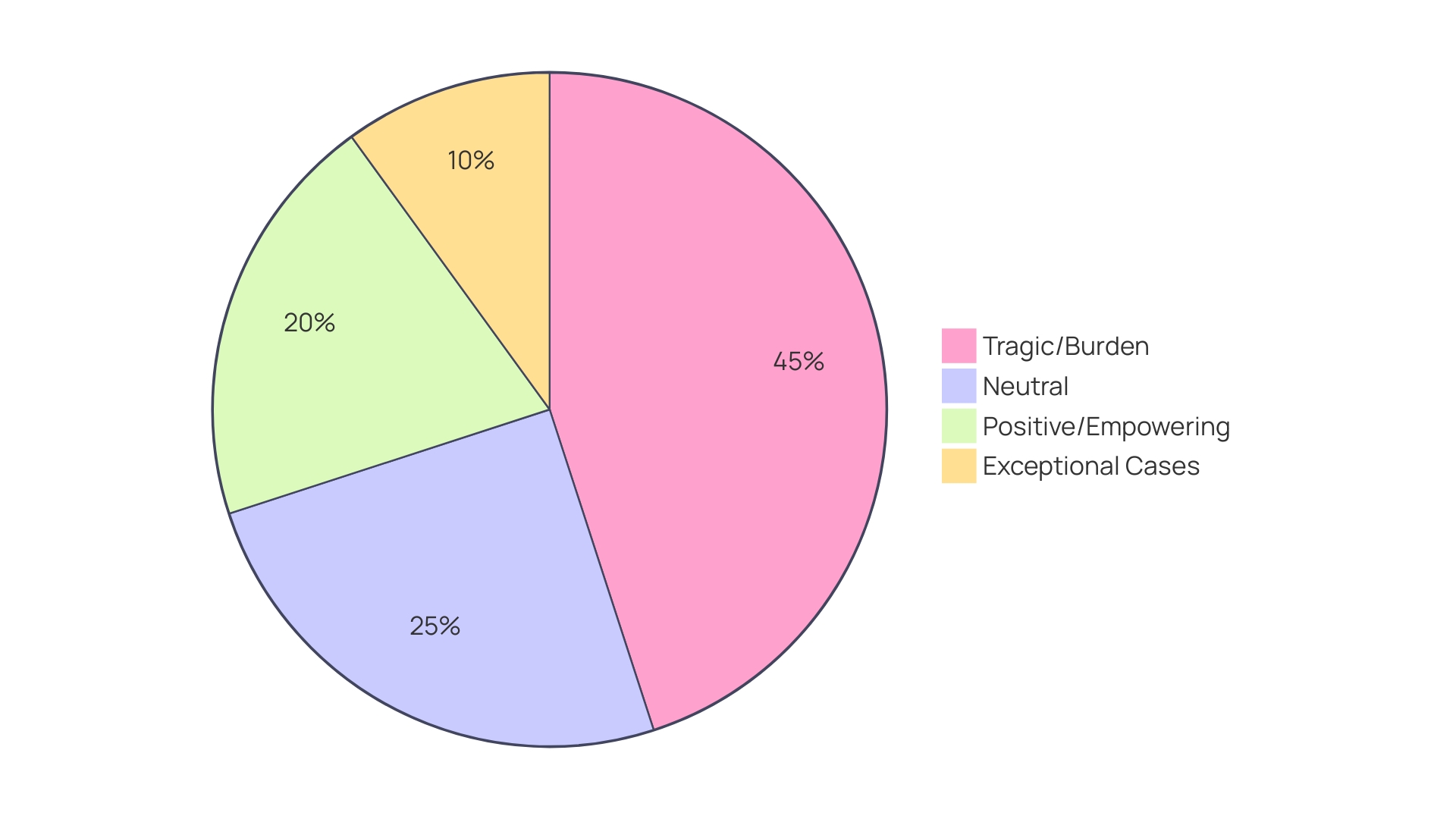
Financial and Resource Allocation Issues
Critics have expressed significant concerns about Autism Speaks' allocation of resources. Historically, a substantial portion of their funding has been directed towards research and awareness campaigns rather than direct support services for autistic people and their families. This financial strategy has sparked debates within the community about its effectiveness in addressing the immediate needs of those impacted by developmental disorders.
One of the primary criticisms is that the focus on research often overlooks the pressing needs for support and services. According to the Autistic Self-Advocacy Network (ASAN), there is a crucial need to reduce disparities in early detection and access to services, which can have long-term impacts on individuals' access to necessary supports. Despite the $5 billion invested in autism research and services since 2006 through the Autism CARES Act, there remains a gap in funding for existing programs and efforts to address the challenges faced by those living with intense behaviors.
Moreover, state Medicaid programs, which many autistic children and adults rely on, can be significantly impactful in providing access to care and services. The Kevin and Avonte Program, for instance, has designated $10.3 million to local initiatives aimed at decreasing fatalities and injuries among people with developmental disabilities who stray from secure surroundings. These types of direct support initiatives emphasize the significance of funding that directly aids the local population.
A shift towards supporting organizations run by and for autistic individuals, such as the Autistic Self-Advocacy Network, is seen as a crucial step. These organizations are believed to have a genuine understanding of the local population's needs, ensuring that funding is utilized effectively to provide tangible benefits. The challenge, however, lies in overcoming the existing political and economic factors that support a medical model of this condition, which views it as a disease rather than part of neurodiversity.
As the group focused on neurodevelopmental disorders keeps pushing for improved resource distribution, it is crucial to acknowledge the varied requirements and guarantee that financial plans are comprehensive and beneficial for direct services that create a significant impact in the lives of people on the spectrum and their families.
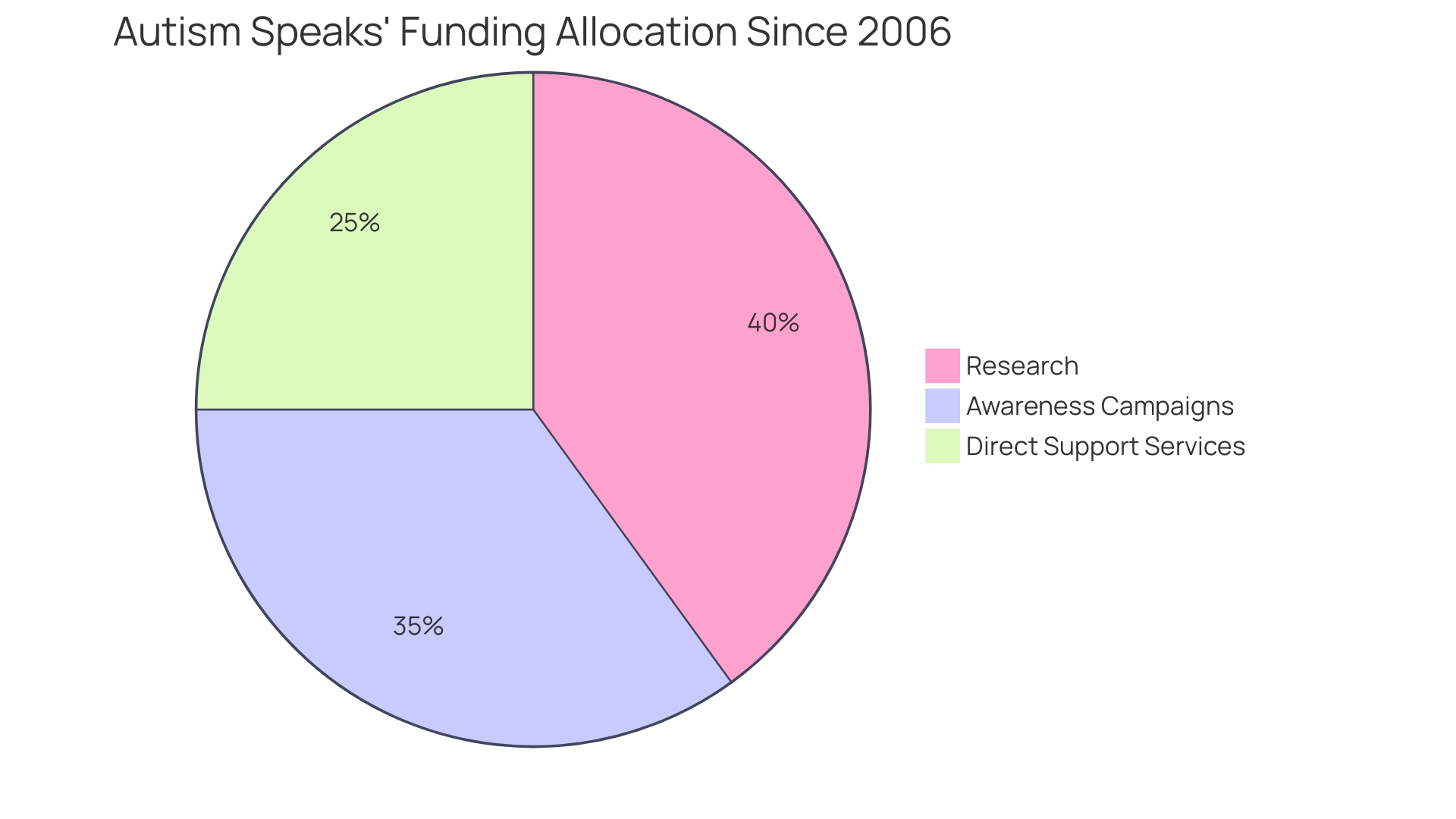
ABA and Therapy Controversies
Applied Behavior Analysis (ABA) therapy remains a controversial topic within the autism community. 'While some families find the structure and strategies of ABA beneficial in teaching new skills and managing challenging behaviors, others criticize it for being overly controlling and not respecting the autonomy of those on the spectrum.'. This dichotomy reflects the broader debate within disability studies, particularly the social model of disability, which views disability as a product of social injustice and emphasizes the importance of context in understanding and treating disabilities (Baglieri et al., 2011; Siebers, 2011).
Autism Speaks’ endorsement of ABA has drawn significant criticism from advocates pushing for more compassionate and inclusive approaches to therapy. Proponents contend that ABA frequently neglects to consider the distinct cultural and social backgrounds of those with autism and instead emphasizes modifying behaviors to align with societal norms. 'This viewpoint corresponds with the issues raised by the Autistic Self Advocacy Network (ASAN), which stresses the necessity for therapies that are respectful and empowering for those on the spectrum.'.
Moreover, the involvement of private equity firms in ABA services has raised concerns about the commercialization of therapies for individuals on the autism spectrum. Critics argue that profit motives can sometimes overshadow the well-being and individual needs of autistic people, leading to a one-size-fits-all approach that may not be beneficial for everyone. The discussion surrounding ABA highlights the importance of continuous conversation and investigation to create strategies that genuinely assist the varied requirements of the neurodiverse community.
Eugenics and Prenatal Testing Concerns
'Autism Speaks' position on prenatal screening for developmental disorders has ignited considerable moral discussions, drawing parallels to eugenics. Critics argue that advocating for prenatal screening may place undue societal pressure on parents to terminate pregnancies if a developmental disorder is diagnosed, potentially devaluing the lives of individuals with such conditions. This ethical dilemma is reminiscent of concerns raised by parents facing prenatal diagnosis of conditions like Down syndrome, who worry whether such decisions might constitute eugenics. The issue underscores the complexity of navigating a culture where 'knowledge is power,' especially when that knowledge can lead to ethically fraught decisions made under pressure. As one paper notes, understanding the context and the reliability of these tests is crucial, as high-risk results can vary significantly based on different populations and measures.
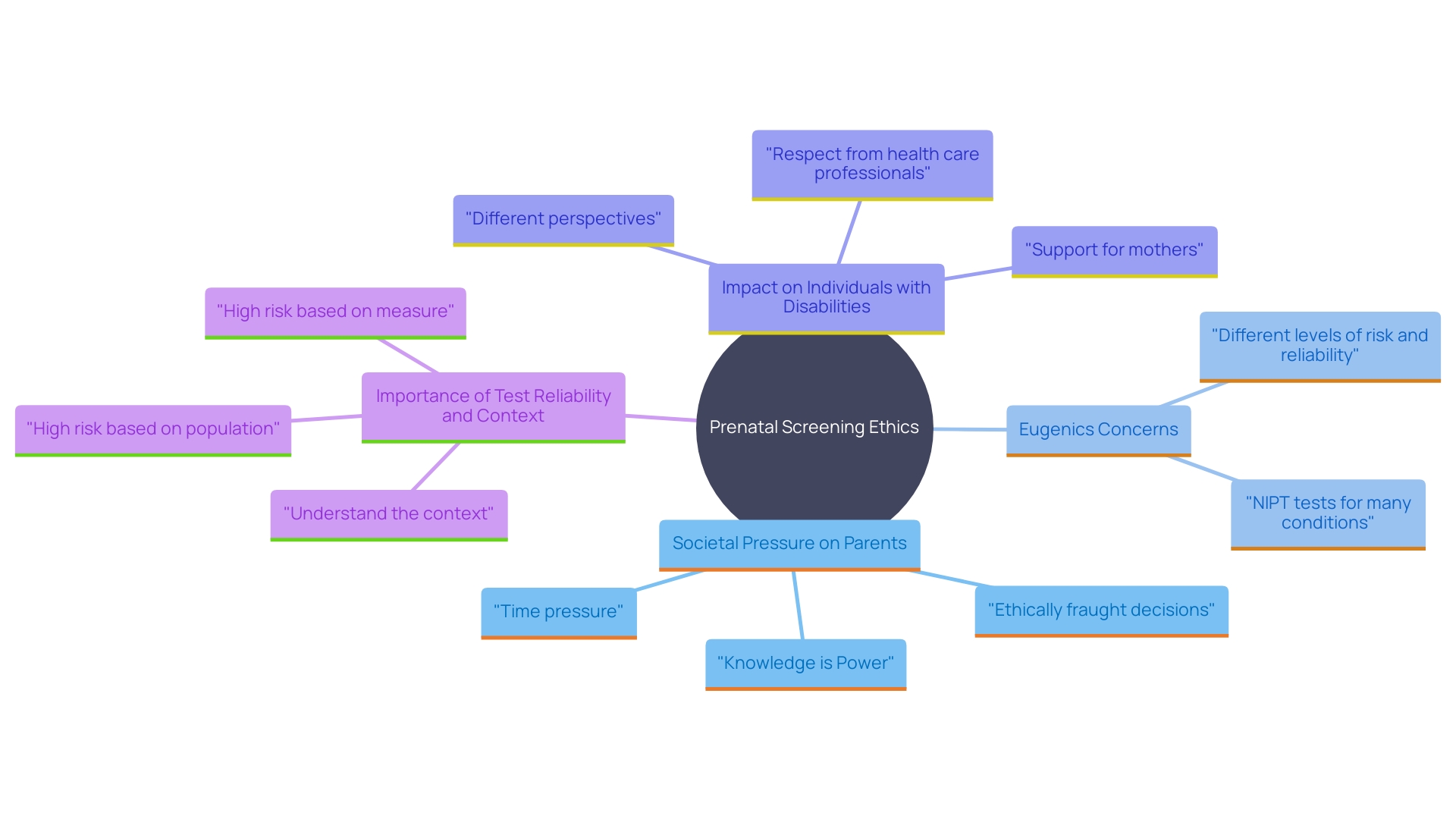
Silencing Autistic Voices
The community of individuals on the spectrum has long felt marginalized by Autism Speaks, believing that their voices have been historically silenced. This feeling has prompted a broader discussion about the importance of prioritizing the viewpoints of individuals on the spectrum in conversations regarding this condition. The Autistic Self Advocacy Network (ASAN), a prominent group operated by and for people on the spectrum, highlights that significant assistance and comprehension can only be attained by hearing from those who experience it every day. ASAN's mission is to ensure that individuals on the autism spectrum are included in policymaking, thus guaranteeing that laws and policies address their specific needs.
Recent studies emphasize a concerning link between autism and mental health issues, such as depression and suicidality, which are more common among people with autism than in the general population. Despite this, individuals on the autism spectrum have often been excluded from mental health research and clinical trials, leading to a deficiency in treatment options tailored to their needs. This exclusion underscores the importance of community-based methods to develop effective interventions.
Moreover, the economic benefits of inclusive employment practices cannot be overstated. Businesses that actively recruit persons with disabilities, including those on the autism spectrum, have demonstrated better financial results. A national analysis indicated that the U.S. GDP could increase by up to $25 billion if more people with disabilities entered the workforce, demonstrating their value to both businesses and the economy.
Activists argue that disability rights are human rights, advocating for greater acceptance and expanded civil rights protections. This includes increased access to employment, safe housing, healthcare, and meaningful participation in public life. The annual Day of Mourning vigil, which honors disabled persons killed by their caregivers, serves as a poignant reminder of the ongoing fight for justice and recognition of disabled lives. Ultimately, centering the perspectives of individuals on the autism spectrum in all aspects of advocacy and policy is essential for creating a more inclusive and supportive society.
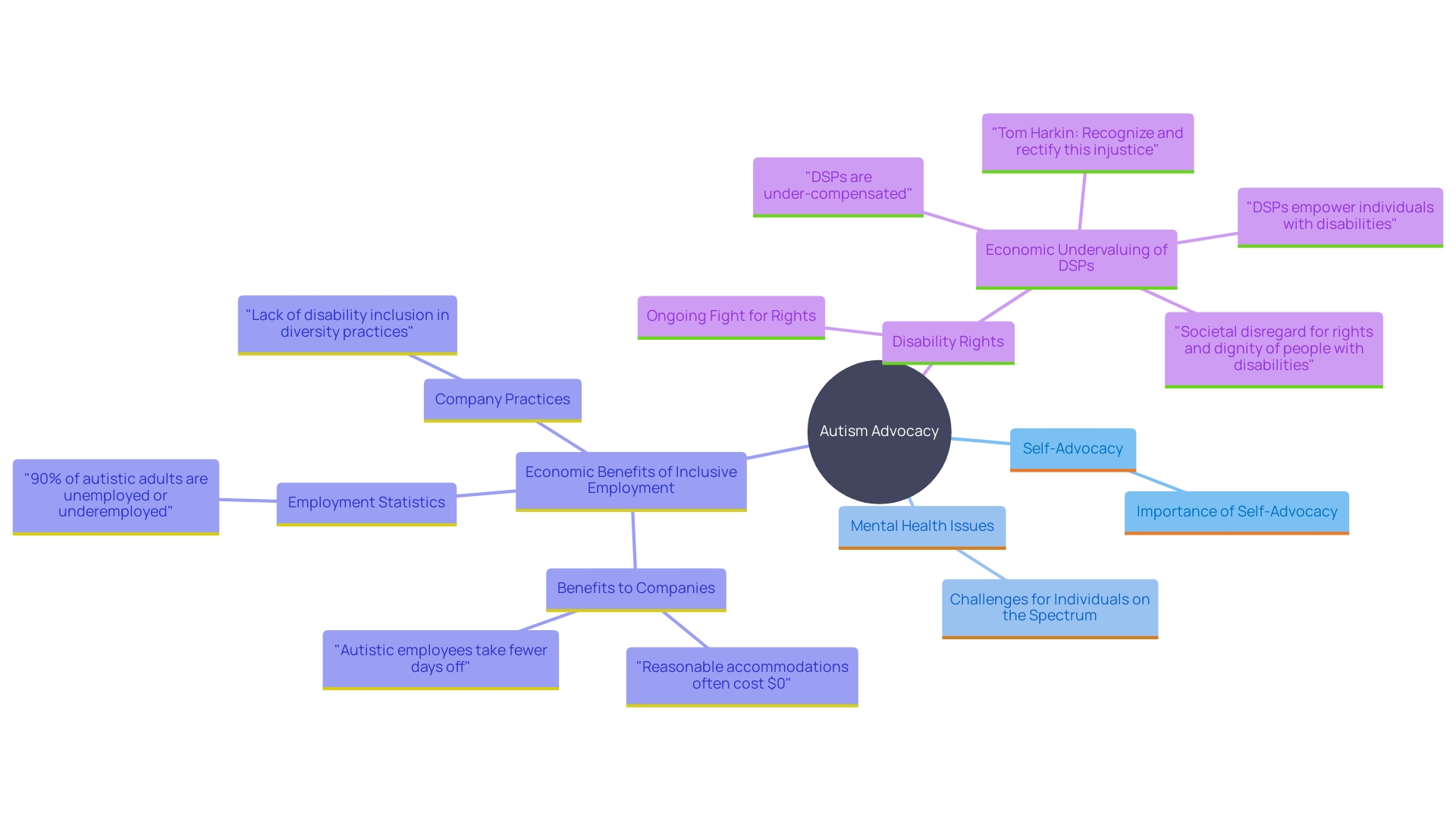
Changes and Reforms Over Time
In response to growing criticism, Autism Speaks has undertaken significant measures to reform its policies and practices. By actively working to include individuals on the autism spectrum in leadership and advisory roles, they aim to enhance their credibility and effectiveness. 'This shift towards inclusivity is pivotal, as highlighted by the Autistic Self Advocacy Network (ASAN), which emphasizes the importance of autistic people being involved in policymaking to ensure that laws and policies meet the needs of their group.'. Despite these efforts, skepticism remains about whether these changes will translate into meaningful progress. Historical missteps, such as the controversial 'I Am Autism' video, have left lingering doubts among the group. 'Autism Speaks has recognized these previous errors, observing that their enhanced comprehension of the condition today has transformed their strategy.'. 'The journey towards genuine inclusivity and representation is ongoing, and only time will reveal if these initiatives will cultivate the trust and support of individuals on the spectrum.'.
Alternative Organizations and Support
The emergence of alternative groups that emphasize the perspectives of people on the spectrum has brought about a considerable change in the related community. Groups like the Autistic Self Advocacy Network (ASAN) champion neurodiversity and inclusivity, offering support and resources that align more closely with the lived experiences of autistic individuals. 'This movement is part of a broader neurodiversity initiative, a concept attributed to sociologist Judy Singer in 1998, which views neurological differences such as being on the spectrum and ADHD as natural variations rather than disorders needing cures.'. Over 25 years, the neurodiversity movement has transformed from a niche concept to a mainstream discussion, influencing academic and societal views on the condition.
ASAN's advocacy emphasizes the necessity for prompt diagnosis and interventions to lessen inequalities in early identification and access to services, striving to enhance long-term results for those on the spectrum. The organization also supports research into the biology of this developmental disorder and its co-occurring conditions, promoting understanding across the lifespan from childhood to adulthood.
The increasing need for change within the community highlights the significance of acknowledging and honoring the variety of experiences among individuals on the spectrum. This shift not only challenges traditional medical models that pathologize autism but also fosters environments where autistic voices are heard and valued, paving the way for more inclusive and supportive practices.
Conclusion
The scrutiny of Autism Speaks highlights significant challenges in autism advocacy. Historical missteps, such as the "I Am Autism" video, reveal a past focus on awareness rather than genuine representation. Advocates call for a shift toward celebrating neurodiversity, ensuring that autistic voices are authentically included and respected.
A major concern is the lack of autistic representation in leadership roles. Organizations like the Autistic Self Advocacy Network (ASAN) demonstrate the value of incorporating lived experiences into decision-making. Additionally, media portrayals often perpetuate harmful stereotypes, emphasizing the need for accurate representations of autistic individuals.
Financial allocation issues further complicate the landscape, with much funding historically directed toward research instead of direct support services. This gap necessitates a reassessment of resource distribution to better meet community needs. The endorsement of Applied Behavior Analysis (ABA) raises ethical questions, highlighting the importance of more compassionate approaches that respect autonomy.
As discussions around prenatal testing and potential eugenics continue, centering autistic voices remains crucial. While Autism Speaks has made strides to reform and include autistic individuals in decision-making, skepticism about the authenticity of these changes persists.
The emergence of alternative organizations advocating for neurodiversity marks a transformative shift in autism advocacy. By prioritizing and celebrating autistic experiences, these groups challenge traditional paradigms and foster a more inclusive and supportive society. Embracing this diversity is vital for promoting understanding and acceptance within the autism community.




